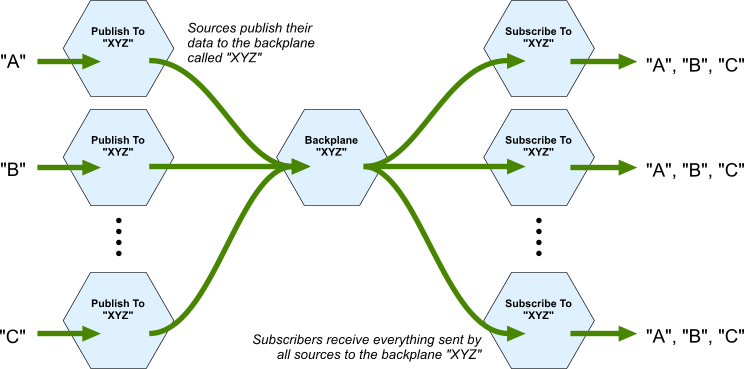April 2024 - This site, and Kamaelia are being updated. There is significant work needed, and PRs are welcome.
Cookbook : Backplanes
Backplanes provide an easy way to distribute data from many sources
to many destinations. For example
Serving to multiple clients
For example, perhaps we want to build a server where each client that connects receives a copy of a stream of data - perhaps the current time. First, lets create our source of time data:
from Axon.ThreadedComponent import threadedcomponent import time class TimeTick(threadedcomponent): def main(self): prev="" while 1: now = time.asctime() + "\n" if now!=prev: self.send(now, "outbox") prev=now else: self.pause(0.1)
We're going to use SimpleServer to provide a simple TCP server to
clients. Every time a client connects, we could make a new, private
instance of TimeTick to handle that client. Alternatively we could make
a single TimeTick component that sends (publishes) its messages to a
Backplane:
from Kamaelia.Util.Backplane import Backplane from Kamaelia.Util.Backplane import PublishTo from Kamaelia.Chassis.Pipeline import Pipeline Backplane("TIME").activate() Pipeline( TimeTick(), PublishTo("TIME"), ).activate()
Then for each client that connects, we ask SimpleServer to make a
component that fetches (subscribes) from that same backplane:
from Kamaelia.Util.Backplane import SubscribeTo from Kamaelia.Chassis.ConnectedServer import SimpleServer SimpleServer(protocol=lambda : SubscribeTo("TIME"), port=1500).run()
So what's going on?
Notice we've named the Backplane "TIME" to distinguish it from other
Backplanes. You can therefore have as many Backplanes in a system as you
like. The SubscribeTo and PublishTo components connect to the right
backplane because they look it up (by the name) using the Coordinating
Assistant Tracker (CAT). Once the subscribers and publishers are all
linked up, you get something like this:

PublishTo components send anything that arrives at their "inbox" inbox
onto the Backplane. SubscribeTo components talk to the backplane and
send on anything they receive from it to their "outbox" outbox. The
Backplane itself acts like a splitter component - anything it receives
is sent onto all outputs; in this case - all subscribers.
Couldn't we have done that more simply?
For a really simple example like this, there is little or no benefit of doing it this way ... in fact, it might seem like unnecessary extra effort and components! However, the real power is that all the clients are sharing the same data source.
A simple relay server
Perhaps, for example, our source of data is actually coming from another server (say "foo.bar.com" on port 1600). Using a backplane, its easy to build a relay server capable of replicating the data to multiple clients:
from Kamaelia.Internet.TCPClient import TCPClient Pipeline( TCPClient("foo.bar.com", port=1600), PublishTo("DATA"), ).activate() Backplane("DATA").activate() SimpleServer(protocol=lambda : SubscribeTo("DATA"), port=1600).run()
An aggregating logger...
Backplanes aren't just useful for distributing data in a one-to-many fashion; they can also be used for many-to-one or many-to-many. For example, we can use a Backplane to build a logging server capable of logging, to a single file, data received from multiple clients. In effect, a simple aggregating logger:
from Kamaelia.Visualisation.PhysicsGraph.chunks_to_lines import chunks_to_lines from Kamaelia.File.Writing import SimpleFileWriter def sendToBackplane(): return Pipeline( chunks_to_lines(), PublishTo("LOGGER"), ) SimpleServer(protocol=sendToBackplane, port=1500).activate() Pipeline( SubscribeTo("LOGGER"), SimpleFileWriter("log.data"), ).activate() Backplane("LOGGER").run()
...that can also be a relay
Because we use a Backplane and a SimpleServer chassis, the client connections are not hard wired - clients can connect and disconnect whenever they choose. In fact, we could extend this further, by allowing clients to connect on a different port to receive a live stream of the aggregated logging data:
SimpleServer(protocol=SubscribeTo("LOGGER"), port=1501).activate()
Our aggregating logger is now also a relay, using the backplane to distribute messages from many sources to many destinations.
-- Jan 2007, Matt
